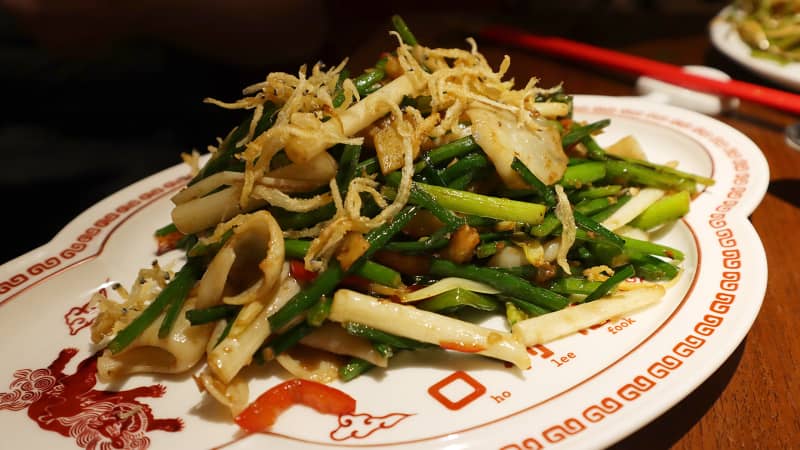Hong Kong (CNN) — Archan Chan recalls her first experience working in a Chinese restaurant, more than 14 years ago.
Employed as an apprentice chef, she was one of just two woman in the kitchen — the other’s sole job was to beat eggs.
“She was unbelievably fast at beating eggs. I guess for a woman to survive in a traditional Chinese kitchen back then, you had to be the best in something,” says Chan.
After spending more than a decade working in fine dining restaurants and gastro-bars in Australia and Singapore, Chan is one of the few female chefs to rise to top of a high-end Cantonese restaurant.

Archan Chan is one of the few female chefs to rise to top of a high-end Cantonese restaurant.
Maggie Hiufu Wong/CNN
An impressive feat, given how incredibly challenging it has been for women to soar in high-profile Chinese kitchens.
Why are there so few females willing to don the chef’s apron? The physically demanding kitchen tools and setup, the fierce fire of the wok and a male-centric culture are just a few of the deterrents, with women once told they lack the strength to handle such a grueling industry.
But more like Chan are proving doubters wrong.
Why women are rare in Chinese kitchens
Female chefs have long been a minority in professional kitchens around the world. But the situation is even bleaker in Chinese kitchens.
In traditional Chinese kitchens, where all sorts of regional cuisines are served, chefs are generally divided into two groups: there are those who man the stove station, preparing wok and stir-fry dishes; and then there’s the pastry station, where the dim sum and noodles are made.
There’s no denying the work is physically demanding — an empty wok weighs about 2.2 kilograms — but there are other factors at play.

Ho Lee Fook’s classic steamed threadfin, served with chicken oil and Shaoxing wine.
Maggie Hiufu Wong/CNN
In the past, many Chinese kitchens focused on mentor-protégé relationships, meaning masters would recruit apprentices and pass their skills to them. Few chefs would risk recruiting a female trainee into that harsh environment.
Given all of these barriers, not many women would even consider this male-dominated industry as an attractive career path.
“Until about a decade or so ago, the only women I met working in Chinese kitchens were kitchen hands, who clean and do some basic preparations, or dim sum cart pushers,” says Chun Hung Chan, who has been a chef for the last 46 years and an instructor at Hong Kong’s Chinese Culinary Institute for 28 years.
The rise of female Chinese chefs
In an ideal world, a story like this one, or the annual awards that highlight the “best female chefs,” wouldn’t be necessary. Women would simply thrive alongside everyone else in the kitchen, and be treated with the same level of respect.
Thankfully there are signs of a shift in mindset — the number of female Chinese chefs de cuisine has been rising in recent years.
Among them is Zeng Huai Jun, the executive chef of Song, a one-Michelin-star Sichuanese restaurant, in Guangzhou.
And then there’s Li Ai Yin of Family Li Imperial Cuisine in Beijing, and May Chow of Little Bao and Happy Paradise in Hong Kong — both well-recognized chef-owners of Chinese restaurants.
Chef and culinary teacher Chun Hung Chan attributes this growth to publicity, TV celebrity chefs and improved working environments.
“Before the 2000s, only about 3% of my students were female. It has risen to about 18-20% in the last decade or so,” he says. “We hope that in eight years or less, we will have our first-ever female Master Chef graduate.”
The highly coveted Master Chef course only happens every other year, and is offered to nominated chefs of Chinese kitchens who have over 12 years of experience.

A fresh graduate of the Chinese Culinary Institute, Amy Ho is now a dim sum chef at Hong Kong’s Great China Club.
Courtesy Chinese Culinary Institute
In a few years, recent graduate Amy Ho could very well be one of them. More interested in cooking than studying early on in her life, she enrolled herself in a two-year course at the Chinese Culinary Institute.
“I used to not take my work and study seriously. After becoming a chef, I have changed a lot. I opened up and would always ask my instructors to teach me more,” says Ho.
“I remember the first time I learned to make a xiao long bao at a Shanghainese restaurant, I did it better than other new chefs who were men. You can’t stuff too much or too little fillings in each of them and you need to close the xiao long bao wrapper by folding 36 pleats on top. I was so pleased with my first try I took a picture,” she recalls.
Since graduating a year ago, Ho has found a full-time job as a dim sum chef at Great China Club, a Cantonese restaurant in Hong Kong.
“It was a bit hard for girls to look for a position in Chinese restaurants as they may have doubts in our determinations and physical strength at first. It was quite foreign for them. But I think if we were given a chance, we could prove otherwise,” Ho says.
She is the only female chef in the kitchen. Her current goal is to improve her English so she can easily communicate with her global counterparts as she climbs the culinary ladder.
“I am actually better at grasping the concepts behind some of the dim sum and making them better than some of my fellow chefs,” Ho adds.
Archan Chan, Ho Lee Fook’s new head chef, prefers working at the wok station.
Since taking over Ho Lee Fook last December, she has made some changes to the menu. The eatery has recently gone through a reinvention, taking the focus off fusion Chinese fare to become an authentic Cantonese restaurant.
Dishes feature unique twists that don’t sway too far from their roots. For instance, the crispy local chicken is paired with a sand ginger sauce that’s freshly chopped instead of served in a paste. The steamed razor clams are paired with aged garlic.
“(The dish) ‘Stir Fry King’ was first invented by an eatery in Sham Shui Po (a district in Kowloon, Hong Kong) with relatively premium ingredients like flowering garlic chives and cashew nuts,” says Archan Chan.

Archan Chan says that a good ‘Stir Fry King,’ a classic Cantonese dish, should offer rich flavors and textures.
Maggie Hiufu Wong/CNN
Archan Chan is one of two women on the restaurant’s eight-chef team.
“We have a very open mindset at our kitchen. There is a Chinese saying that says ‘a long journey reveals the strength of a horse.’ Even if it’s a male-dominant kitchen, all everyone cares about is food — the cooking. They don’t care if you’re a male or female. Gender shouldn’t matter,” she says.
Welcome to Wendy’s Wok World

Sam Lui, a philosophy graduate, started running Wendy’s Wok World in 2019.
Courtesy Wendy’s Wok World
Sam Lui, a philosophy graduate, started running Wendy’s Wok World in 2019. It’s become one of the most talked-about food projects in Hong Kong over the last year.
The conceptual project documents Lui’s alter-ego, Wendy, on her path to learn and hone her wok skills. She has worked in different Chinese kitchens and served friends at a private kitchen at a soy farm.
“When I started Wendy’s Wok World, it was a personal project using food as a medium, to explore and express the concepts of authority and rigidity,” says Lui.
“I have been fascinated by the wok. It’s so different from other ways of cooking…All principles must be internalized into the very being of the person.”
And just because it’s a conceptual project, that doesn’t mean Lui isn’t serious about her training.
“When Wendy works in kitchens, she is a person who would stay behind after her shift ends at midnight and ask for more directions from the senior chefs,” says Lui of her alter ego’s mindset.
The latest dish Wendy has been practicing is bat si (stringy sugar). It’s made by coating food with caramelized sugar that is thick enough to hang onto the ingredients but light enough that it creates strings of sugar when you pick up the food.
Being recognized for her role in elevating the status of female chefs over the past year has surprised Lui — she never meant to make a statement with her project.

A plate of salted egg yolk prawns, a dish Wendy has been working to perfect.
Courtesy Wendy’s Wok World
“I think the past year of noticing what Wendy has represented for other people as a ‘female chef in a Chinese kitchen’ has been interesting for me to note as well… The fact that it is seen as a statement is truly a testament to the common perception of Chinese kitchens as not being friendly to females. Which from my experience is largely only a self-fulfilling myth,” adds Lui.
She says every chef she has encountered so far has been eager to share their skills.
“Yes, there is a physical barrier but I think the mental barrier may be more obstructive to the increase of women in Chinese kitchens,” says Archan Chan of Ho Lee Fook.
“Dangling a three-kilogram goose over a roast oven with one hand while pouring oil onto it is physically demanding even to men. The difference is I am quite short so I have to stand on a stool when doing it,” she says, showing us some of the recent scars she got working over the roast oven — which looks more like an oversized pot.
“The 15-liters of oil weighs the same in every kitchen. It isn’t just about how much you want it but how much hard work you’re willing to put into it,” says Archan Chan.
“There are days when you feel like your arms are falling apart and you can’t move them anymore, but the next day, you’re stronger and may be able to work a heavier wok.”
She still has wok dishes on her wish list that she thinks will take another decade to perfect, but adds, “I definitely want to be in a place where I could promote Cantonese and Chinese cuisine in the future.”
Top image: Archan Chan of Ho Lee Fook. Credit: Maggie Hiufu Wong/CNN
